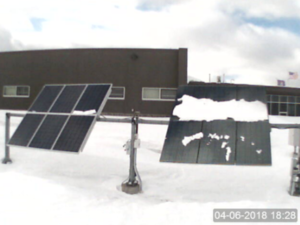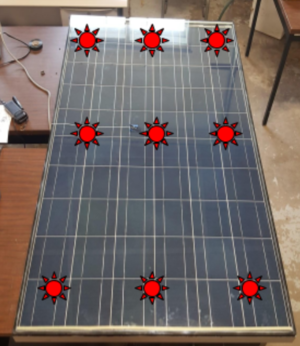No edit summary |
No edit summary |
||
| Line 9: | Line 9: | ||
[[File:TempSenLocation.PNG|thumb|Fig 2: Temperature testing locations for the Energized Glass to verify consistent temperature]] | [[File:TempSenLocation.PNG|thumb|Fig 2: Temperature testing locations for the Energized Glass to verify consistent temperature]] | ||
Two experiments were preformed for this project. The first was to ensure that the Energized Glass was properly working. A temperature sensor was placed in nine locations on the solar modules to verify a consistent temperature across the surface. Although both data sets showed variance between panel zones, it was only by about a degree or so. This narrow variance in temperature was found to be sufficient for the scope of this project. From this, it was determined that the panel temperature is fairly constant throughout, and no additional temperature equipment was necessary for further experimentation. | Two experiments were preformed for this project. The first was to ensure that the Energized Glass was properly working. A temperature sensor was placed in nine locations on the solar modules to verify a consistent temperature across the surface. Although both data sets showed variance between panel zones, it was only by about a degree or so. This narrow variance in temperature was found to be sufficient for the scope of this project. From this, it was determined that the panel temperature is fairly constant throughout, and no additional temperature equipment was necessary for further experimentation. | ||
The second experiment was to determine the performance difference between the control and EG modules without snow. | |||
Revision as of 19:31, 13 July 2018
Introduction

The goal of this project was to test the feasibility of placing heated glass on a solar module to remove snow. This project was preformed by the the Alternative Energy Enterprise Solar Team in the fall of 2017 and spring of 2018. The team worked with the Keweenaw Research Center in Calumet, Michigan where twelve Yingli 240 solar modules were mounted. Six of the modules were the control group and were left unmodified. The other six modules were retrofitted with Energized Glass (EG), heated glass.
Results

Two experiments were preformed for this project. The first was to ensure that the Energized Glass was properly working. A temperature sensor was placed in nine locations on the solar modules to verify a consistent temperature across the surface. Although both data sets showed variance between panel zones, it was only by about a degree or so. This narrow variance in temperature was found to be sufficient for the scope of this project. From this, it was determined that the panel temperature is fairly constant throughout, and no additional temperature equipment was necessary for further experimentation.
The second experiment was to determine the performance difference between the control and EG modules without snow.